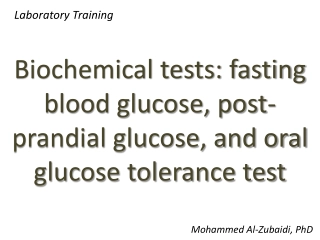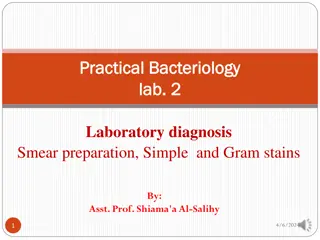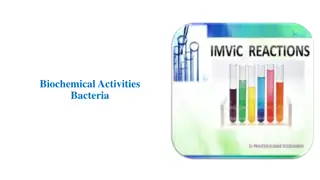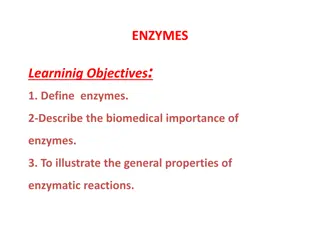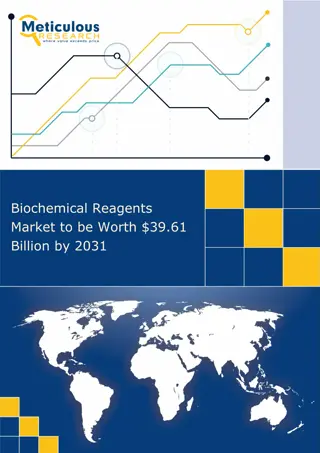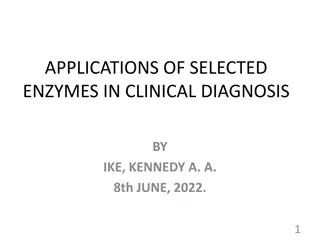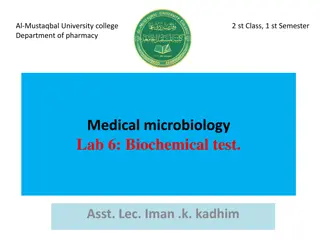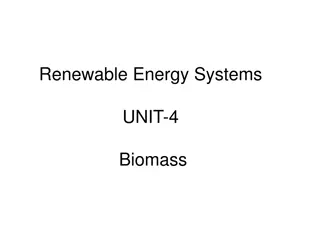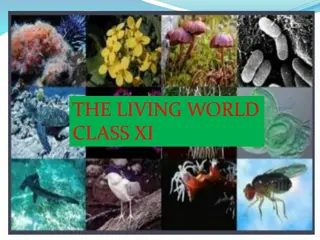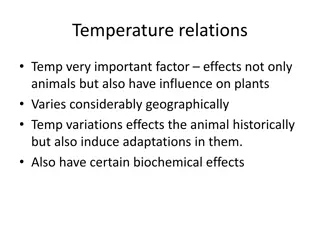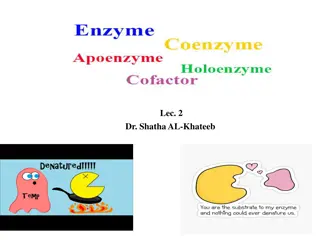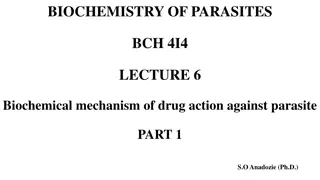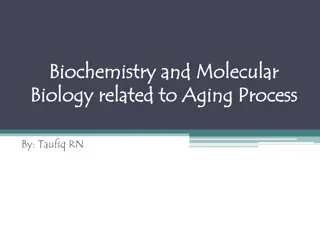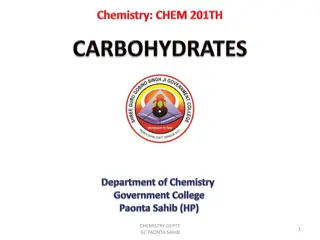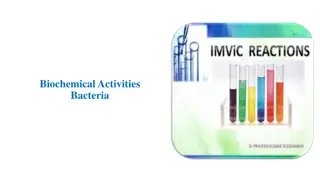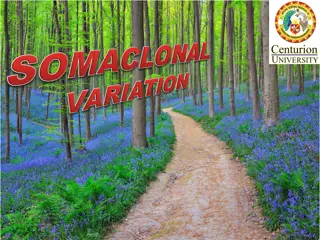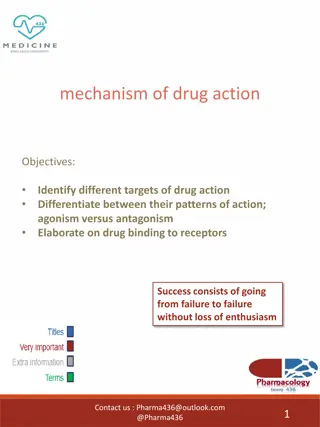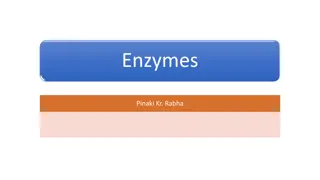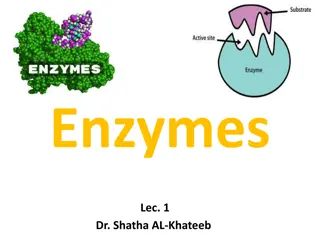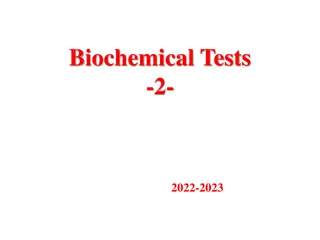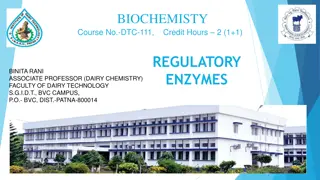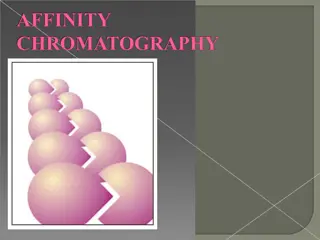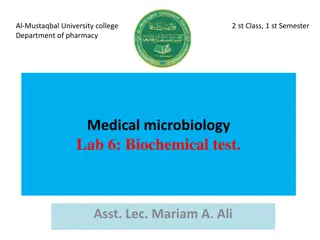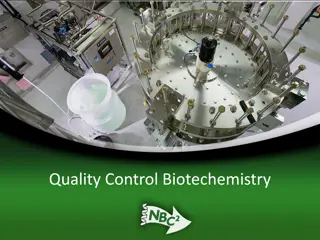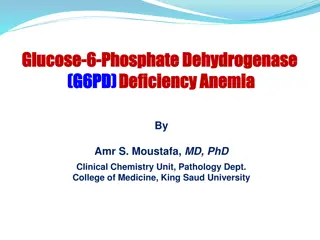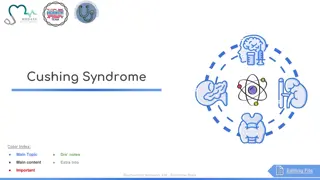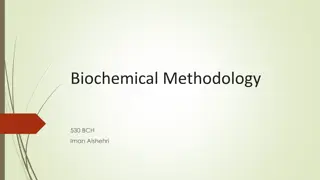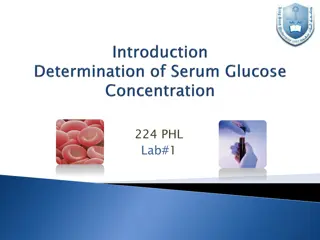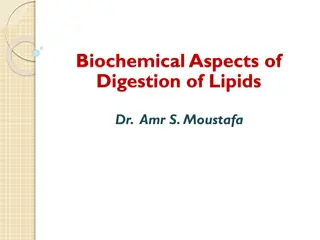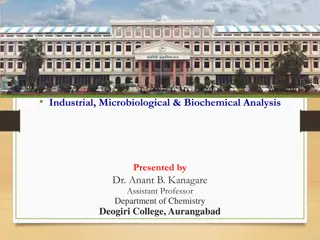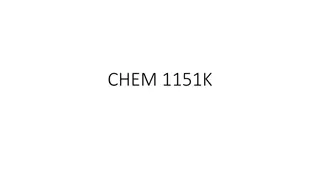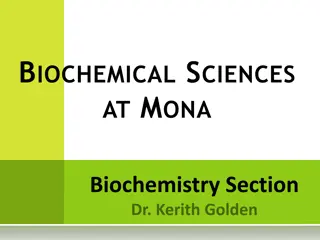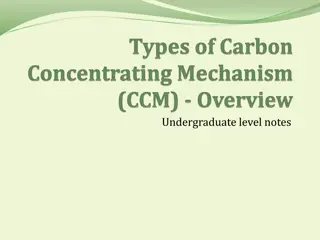Comprehensive Biochemical Tests Training Guide
Enhance your skills in conducting fasting blood glucose, post-prandial glucose, and oral glucose tolerance tests with this comprehensive training guide by Mohammed Al-Zubaidi, PhD. Master the techniques and interpretations for accurate results.
1 views • 42 slides
Biochemical Reactions
Exploring the basics of chemical reactions, the conservation of matter principle, exothermic and endothermic reactions, and the role of activation energy in jumpstarting reactions. Learn how elements transform to create products, the significance of energy release or absorption, and the essential co
3 views • 19 slides
Diabetic Ketoacidosis: Understanding Metabolic Acidosis in Diabetes
Explore a case study on diabetic ketoacidosis to understand the basis of metabolic acidosis in type 1 diabetes mellitus, differentiate between type 1 and type 2 diabetes, predict blood buffer equilibrium changes, apply Winter's formula, correlate clinical data with biochemical tests, explain insulin
3 views • 34 slides
Practical Bacteriology Laboratory Diagnosis and Sample Collection
This practical guide focuses on laboratory diagnosis steps in bacteriology, covering specimen collection, microscopic examination, culture tests, biochemical tests, serological tests, and molecular tests. Learn about various sample collection methods for urine, stool, swabs, sputum, pus, CSF, and mo
3 views • 23 slides
Understanding Biogas Production from Kitchen Waste for Green Energy Solutions
Biogas, a methane-rich gas produced from organic waste, offers an eco-friendly energy solution through anaerobic digestion. Learn about its composition, advantages, and disadvantages, as well as the biochemical reactions involved in its production. Discover the various modes of operation and types o
7 views • 22 slides
Bacterial Biochemical Identification Tests in Microbiology
Understand the significance of biochemical tests like the Triple Sugar Iron Agar Test (TSI) and the IMViC Test for identifying enteric bacteria. Learn about indole production, methyl red test, and other methods used in bacteriology.
5 views • 17 slides
Understanding the Seliwanoff Color Reaction and its Significance
The Seliwanoff color reaction, discovered by Russian chemist Feodor Feodorovich Selivanov, is used to differentiate between aldoses and ketohexoses based on their dehydration and reaction with resorcinol in acidic conditions. Ketoses like fructose react faster than aldoses like glucose, leading to a
3 views • 20 slides
Understanding Enzymes: Importance and Clinical Applications
Enzymes are vital proteins that speed up chemical reactions without being consumed, playing a crucial role in various physiological processes. They require cofactors for optimal function, and their levels in blood can indicate tissue damage or disease. Learning about enzymes is essential for underst
6 views • 25 slides
Biochemical Reagents Market
Meticulous Research\u00ae\u2014a leading global market research company, published a research report titled, \u2018Biochemical Reagents Market by Type (PCR, Chromatography, Cell & Tissue Culture, Flow Cytometry, Electrophoresis, Immunoassay) End User (Pharmaceutical & Biotechnology, CRO, Diagnostic
1 views • 4 slides
Applications of Enzymes in Clinical Diagnosis: A Comprehensive Overview
Enzymes play a crucial role in cellular metabolism and are essential for various biochemical reactions in living organisms. This detailed study explores the sources, classification, properties, and factors affecting enzymes, emphasizing their applications in diagnostic and analytical processes. By h
1 views • 35 slides
Microbiology Lab Tests for Identifying Bacterial Pathogens
Learn about key biochemical tests like the Coagulase Test, Catalase Test, and Oxidase Test used in medical microbiology to identify pathogenic bacteria such as Staphylococcus aureus. Understand the methods, significance, and interpretation of results for each test.
4 views • 17 slides
Comprehensive Overview of Molecular Diagnostics, Cytogenetics, and Forensic Biology
Explore a detailed curriculum covering molecular diagnostics, traditional disease diagnosis methods, genetic disorders, cytogenetics, molecular techniques, biochemical tests, PCR applications, immunoassays, and forensic biology including microbial forensics, entomology, botany, serology. Lectures co
1 views • 4 slides
Renewable Energy Systems - Biomass Energy Conversion and Applications
Biomass, a renewable energy source, is abundantly available in organic matter such as dried woods, leaves, and cow dung. Through photosynthesis, solar energy is converted into biomass energy. Different conversion processes including direct combustion, thermochemical, and biochemical methods are util
0 views • 30 slides
Understanding the Characteristics of Living Organisms
Life is a unique biochemical process expressed through chemical reactions leading to growth, development, responsiveness, adaptation, and reproduction. Living organisms exhibit characteristics such as growth, definite shape and size, reproduction, metabolism, and cellular organization. These traits
4 views • 32 slides
Understanding the Impact of Temperature on Animals and Plants
Temperature plays a crucial role in influencing animals and plants, affecting their adaptations and biochemical processes. Animals are classified based on their ability to regulate body temperature, with terms like poikilotherm and homeotherm being redefined as ectothermy and endothermy. Ectotherms
0 views • 32 slides
Understanding Enzyme Function: The Key Steps and Importance of Cofactors
Enzymes play a crucial role in catalyzing biochemical reactions by forming enzyme-substrate complexes and facilitating changes in substrate molecules to product molecules. The process involves four steps: proximity of enzyme and substrate, binding at the active site, catalysis leading to substrate a
0 views • 39 slides
Principles of Staining in Histopathologic Techniques
Beginning with an introduction to staining in biochemical techniques, this chapter delves into the types of stains, factors influencing selectivity, and commonly used stains in histopathology. Learning objectives include defining staining, discussing dye-tissue affinity, understanding selectivity fa
2 views • 107 slides
Understanding Biochemical Mechanisms of Drug Action Against Parasites
Parasitic protozoa cause devastating diseases in humans and animals, and chemotherapy is the primary defense. Drug resistance is a challenge, and prevention is crucial. Modern tools aid in studying genetic and biochemical aspects, targeting the parasite selectively. Drugs act by interfering with spe
1 views • 15 slides
Understanding Aging Process from a Biochemical Perspective
Biochemistry and Molecular Biology play crucial roles in understanding the aging process, focusing on the biochemical basis of life, the basis of health, major causes of diseases, and theories of aging. Aging is described as the accumulation of damage due to reactive oxygen species, with theories en
2 views • 11 slides
Epimerisation of D-Glucose into D-Mannose: Structural Insights
Explore the fascinating process of epimerisation, specifically the conversion of D-glucose into D-mannose. Discover the limitations of open chain structures, the ring structure of glucose, and the evidence supporting it. Learn about the stereochemistry of D-glucose, optical rotation, and the equilib
0 views • 13 slides
Understanding Biochemical Tests for Bacterial Identification
Explore the importance of biochemical tests like Triple Sugar Iron Agar and IMViC in identifying enteric bacteria. Learn about indole production and the Methyl Red test, essential in distinguishing bacterial species based on their metabolic activities. Discover how these tests aid in diagnosing food
2 views • 17 slides
Understanding Somaclonal Variation in Plants
Somaclonal variation refers to genetic variations in plants produced through tissue culture, leading to changes in chromosome structure, growth rate, and fertility. This variation can be caused by physiological, biochemical, and genetic factors, and is detectable through morphological and cytologica
0 views • 21 slides
Understanding Drug Action Mechanisms and Receptor Targets
Pharmacodynamics involves studying the effects of drugs on biochemical and physiological levels, focusing on drug actions through receptor-mediated and non-receptor mechanisms. The interaction between drugs and targets like proteins and enzymes impacts cellular functions. Different binding forces, s
0 views • 9 slides
Understanding Enzymes: Nature, Classification, and Mechanism of Action
Enzymes are biocatalysts synthesized by living cells. They are protein in nature and specific in their action. This article delves into the definition of enzymes, classification based on enzymatic action, enzyme class reactions, structure, and mechanism of enzyme action, highlighting how enzymes pla
1 views • 19 slides
Understanding Enzymes: The Key Catalysts in Biochemical Reactions
Enzymes are biological catalysts that play a crucial role in various life processes by speeding up chemical reactions. They are specific, protein-based molecules that lower the activation energy required for reactions, ensuring proper metabolism and efficiency in living organisms. Factors like pH, t
1 views • 46 slides
Understanding the Triple Sugar Iron Test in Biochemical Analysis
The Triple Sugar Iron Test (TSI) is a crucial biochemical test used to differentiate gram-negative enteric bacilli based on their carbohydrate fermentation and hydrogen sulfide production. By examining color changes, gas production, and precipitate formation, microbiologists can interpret TSI result
2 views • 31 slides
Understanding Regulatory Enzymes in Biochemical Pathways
Regulatory enzymes play a crucial role in controlling the activity of biochemical pathways by responding to the presence of specific molecules. They regulate the pathway's activity, ensuring that products are produced in the required amounts at different times. This article delves into the significa
5 views • 22 slides
Affinity Chromatography: A Breakthrough in Biochemical Research
Affinity chromatography, developed in the 1930s by A. Wilhelm Tiselius, is a vital technique for studying enzymes and proteins. It relies on the specific affinity between biochemical compounds and utilizes matrices like agarose for binding sites. Ligands such as amino and hydroxyl groups play crucia
1 views • 27 slides
Explore Membership Benefits with the Biochemical Society
Elevate your career with the Biochemical Society membership offering various benefits like grants, recognition awards, and cost-saving opportunities for attending events and conferences. Members enjoy access to prestigious journals and free secretariat services for hosting successful conferences. Jo
0 views • 11 slides
Microbiology Biochemical Tests for Bacterial Identification
Learn about important biochemical tests used in medical microbiology, including the Coagulase test for Staphylococcus aureus, the Catalase test for enzyme detection, and the Oxidase test for electron transport chain identification. Detailed methods and result interpretations are provided for each te
0 views • 17 slides
Biochemical Quality Control Processes in Biotechnology
Quality control in biotechnology involves monitoring and regulating the levels of various components and impurities throughout the production process. Common methods of removal or purification include chromatography, filtration, and extraction. Scale-up considerations include changes in utility requ
0 views • 31 slides
Understanding G6PD Deficiency Hemolytic Anemia: Biochemical Basis and Implications
G6PD deficiency hemolytic anemia is an inherited condition characterized by reduced levels of glucose-6-phosphate dehydrogenase (G6PD), leading to impaired production of NADPH. This deficiency affects the Pentose Phosphate Pathway (PPP) and can result in oxidative stress, causing damage to DNA, prot
0 views • 18 slides
Understanding Cortisol and Cushing's Syndrome: Biochemical Insights
This content delves into the physiological and biochemical aspects of cortisol, diagnostic algorithms for Cushing's syndrome, and the interpretation of laboratory and radiological investigations for diagnosis. Explore the adrenal gland's anatomical features, the HPA axis, and glucocorticoid function
0 views • 16 slides
Biochemical Methodology 530 - Lactate Dehydrogenase Extraction and Purification Experiment
This course focuses on the extraction and purification of lactate dehydrogenase (LDH) using a series of procedures involving tissue preparation, centrifugation, and ammonium sulfate precipitation. The methodology includes detailed steps from preparing the extraction buffer to isolating LDH in differ
0 views • 10 slides
Understanding Biochemical Experiments and Blood Components
This content delves into various aspects of biochemical experiments, including qualitative and quantitative methods for substance identification and concentration measurement. It also covers the use of a spectrophotometer and different bodily fluids for analysis. Additionally, it explores the compon
0 views • 20 slides
Biochemical Aspects of Lipid Digestion by Dr. Amr S. Moustafa
This lecture by Dr. Amr S. Moustafa covers the biochemical aspects of lipid digestion, including the process, organs involved, enzymes required, and end products. It discusses the assembly, metabolism, and fate of chylomicrons, as well as the clinical manifestations of diseases related to defective
0 views • 31 slides
Industrial, Microbiological & Biochemical Analysis - Course Overview by Dr. Anant B. Kanagare
Dr. Anant B. Kanagare, an Assistant Professor at Deogiri College, Aurangabad, presents a comprehensive course on Industrial, Microbiological, and Biochemical Analysis (Course Code ACH502). The course covers topics such as Industrial Analysis, Microbiological Analysis, and Biochemical Analysis. Dr. K
0 views • 16 slides
Chemistry 1151K Course Overview and Chapters Summary
Upon completion of the CHEM 1151K course, students will apply the scientific method to investigate chemical questions in allied health, utilize dimensional analysis to solve quantitative problems, communicate effectively using chemical terminology and symbols, describe the behavior of biochemical so
0 views • 44 slides
Department of Biochemical Sciences at MONA: Biochemistry Section, Academic Staff, Research Highlights, and Courses Offered
Explore the prestigious Department of Biochemical Sciences at MONA, specializing in Biochemistry, Anatomy, Physiology, Pharmacology, Physical Therapy, and Dentistry. Learn about the dedicated academic staff, research highlights in medical and plant biochemistry, and offered degrees. Discover the com
0 views • 11 slides
Mechanisms of Carbon Concentration in Plants: Biochemical and Biophysical Variants
Biochemical and biophysical mechanisms of carbon concentration in plants involve variations such as C4 and CAM pathways in higher plants, as well as specific adaptations in algae and cyanobacteria. These mechanisms play a crucial role in efficiently managing carbon fixation processes in different ty
0 views • 6 slides
